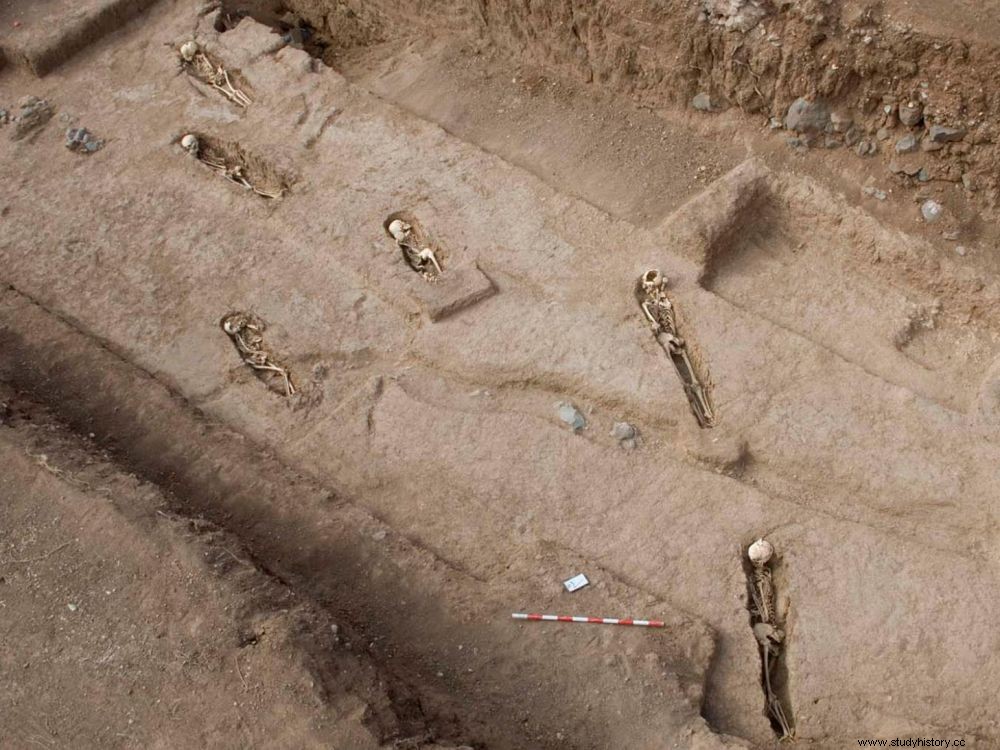Considered one of the first sites in the Atlantic Ocean to have, at 15 e century, imported slaves from the African continent, the Canary Islands could have concealed one of the oldest cemeteries of the slave trade. An article to (re)discover on the occasion of the National Day of Memories of the Slave Trade and Slavery and their Abolition, May 10.

Partial view of the slave cemetery (XV th -XVII e centuries), Finca Clavijo, in the Canary Islands (Spain).
May 10. As every year, this date marks the "National Day of Memories of the Slave Trade and Slavery and their Abolition". On this occasion, we invite you to read this article by our journalist Bernadette Arnaud, originally published on the website of Sciences et Avenir January 31, 2017.
Lying on their side, some have their heads facing east, others are associated with ornaments unknown to the communities of the Canary Islands (Spain); elsewhere, a medal could indicate a case of conversion… These fourteen people buried between the 15 e and 17 e centuries, rest in what is probably the oldest known cemetery of slaves from the Atlantic slave trade! The discovery was made by an international team of archaeologists at Finca Clavijo, near Santa Maria de Guia, in the north of Gran Canaria. This update, which began in fact as early as 2009, could have gone unnoticed if a journalist from the International Business Times echoed it on January 17, 2017, reporting an article by the researchers published in 2016 in the American Journal of Physical Anthropology :archaeologists from the universities of Stanford (United States), Cambridge (United Kingdom), Las Palmas (Spain) and Santa Elena (Ecuador) describe the genetic and isotopic analyzes carried out on samples taken from these human remains.
Foreign funeral practices in the Canary Islands
These allowed them to make the link with populations of North Africa (Moors) and the sub-Saharan zone (from southern Morocco to Senegal), where an intra-African slave trade well before the 15 and century was already very active. It is in these regions that populations were kidnapped to be enslaved in the subtropical islands near Africa. Contacted by Sciences et Avenir , Jonathan Santana, of the State University of Santa Elena (Ecuador), the director of the excavations, confirmed the concordant dates (between 1470 and 1600) in addition to the multiple evidence collected in the graves. Those linked in particular to funerary practices and cultural traditions foreign to the Canary Islands, such as these colored glass beads typical of African rituals.

Glass beads of African origin, found in burials in the Finca Clavijo cemetery (Canary Islands).
A slave trade initiated by the Portuguese and the Spaniards
And above all, the traumas and bone lesions noted on the skeletons attesting to very hard physical work. "Injuries similar to those observed among enslaved populations at Remley sites (South Carolina), as well as Waterloo (Suriname) or Newton (Barbados)", he specifies. It is indeed from the 15 e century, when America had not yet been "discovered" by Christopher Columbus (1492), when the first imports of slave labor took place from Africa for the exploitation of sugar cane in the Canary Islands, Azores, Cape Verde or Madeira. Many historical texts refer to this traffic initiated by the Portuguese and the Spaniards for the development of this monoculture destined to become the pillar of the new Atlantic economy. But no physical trace had been exhumed so far. "Remains we discovered suggest this is the oldest African Diaspora slave cemetery found in the Atlantic “says the scientist.
The precedent of the cemeteries on the island of Saint Helena
Recently, other cemeteries have been discovered on the island of Saint Helena, west of South Africa, where Napoleon Bonaparte was exiled between 1815 and 1821. But these were slaves landed between 1840 and 1864 after being freed from slave ships seized in the Atlantic by the British fleet. England having abandoned the slave trade in 1807, patrols intercepted ships that continued to practice it on the way to America. More than 27,000 people, captured a few months earlier in Africa, were thus freed from 87 slave ships before being transferred to Saint Helena. Several thousand of them, freed, finally settled there until their death. Some sites, directly linked to the Atlantic slave trade, have also been found in recent years, particularly in the Caribbean - such as that of L'Anse Sainte-Marguerite, in Guadeloupe -, or in Rio de Janeiro (Brazil) and other regions of 'America.
But the most important cemetery of African slaves from the colonial era remains to this day the one accidentally unearthed in the Manhattan district of New York in 1991. Thousands of captives were buried there between 1626 and 1794. New York Historical Society estimated that enslaved Africans made up one-fifth of the city's residents then, with New York being the second-largest slave market in the country.
All of this work is of great interest from a genetic point of view. Scientists have the greatest difficulty in determining, with the study of ancient DNA, the origin of the very diverse populations moved between the 16 e and the 19 th century from the African continent. The known geographical information concerning the millions of displaced persons comes mainly from maritime records that only mention the ports of departure. They never report ethnicities or geographical origins.
